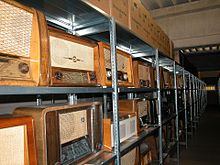Depot (museum)
The rooms in a museum in which the items that are currently not on display are stored and kept are referred to as a depot .
In the early days of museum history , it was a practice to present all of the existing exhibits at the same time, if possible. It was later realized that the associated compression is not only detrimental to the visual impression, but can also be problematic from a safety point of view. Today, depending on the type of museum, 40–90% of the holdings are in the depot.
In the course of the preservation order, there may also be holdings here that will never be exhibited. However, they are available for research in the same way as the archives for written cultural assets.
Storage conditions

Depending on the type of museum, there are different requirements for a depot. Homogeneous collections (e.g. pure oil painting collections) are easier to store than collections in which different material groups are represented. Collections are particularly complex in which materials that have different requirements for temperature and ambient humidity occur on an object, e.g. B. wood and metal. Museums with a cultural and technical history are particularly affected by this. Only compromises can be found here. In general, a climate with the lowest possible fluctuations in humidity and temperature should be aimed for. This climate must be within the scope of what can be expected of the different materials.
Dust is one of the main problems with storing objects. Only good packaging can help here. However, caution is advised here: reliable long-term studies on packaging materials and methods are rare. The packed objects must be carefully observed in order to register possible changes and to avoid storage damage.
For most of the exhibits, with a few exceptions such as B. ivory apart, harmful. Therefore the depot rooms have to be darkened as much as possible. Nevertheless, it must be possible to illuminate them sufficiently for inspection tours and work on the objects.
Classification criteria, labeling and findability
For reasons of air conditioning, storage according to materials is recommended in the depot. The size and format of the objects also play a role. Custom-made shelves, boxes, boxes and pallets are often necessary.
Every object usually has an inventory card attached to the object, on which important information such as inventory number and object description are noted. Often the inventory number is also attached directly to the object.
In smaller museums with a manageable depot area, the locations are sometimes not labeled. From a certain number of objects, however, this becomes confusing. In larger depots, all storage facilities such as shelves, cupboards and mobile shelving systems are clearly labeled. In warehouses there is usually a subdivision into grid squares so that even large objects, e.g. B. cars or printing machines, have a unique location. Today the location of an object is usually recorded in a database (see also: Museum documentation ).
staff
In small and medium-sized museums, managing the depots is usually part of the everyday business of all employees. In larger museums there are specialists, mostly museologists, restorers , registrars or museum technicians. Their job often includes not only managing the depot but also handling loan transactions with other institutions.
Viewing depot
Some museums also offer guided tours through the depot, which ultimately blurs the boundaries between the exhibition area and the exhibition area.
Many museums offer tours of their depots on special occasions (e.g. open monument days ). The depot remains largely unaffected by this in terms of installation and safety technology.
The situation is different with museums that offer regular tours of the depot (e.g. the Überseemuseum in Bremen) or even have entire parts laid out as a display depot (e.g. the Historical Museum in Lucerne). In addition to the questions of presentation, exhibit safety and air conditioning, questions about visitor guidance and safety also arise.
See also
literature
- Martina Griesser-Stermscheg, Tabu Depot. The museum depot in the past and present , Böhlau Verlag, Vienna 2013, ISBN 978-3-205-78894-2
- Martina Griesser-Stermscheg / Stefan Olah (eds.), Museumsdepots / Inside the Museum Storage , Pustet Verlag, Salzburg 2014, ISBN 978-3-7025-0766-4
- Günter S. Hilbert: Collection items in security . Gebr. Mann Verlag, Berlin 2002, ISBN 3-7861-2348-9 .
- Landschaftsverband Westfalen-Lippe, Westfälisches Museumamt (Ed.): Inventory, documentation, inventory preservation . 4th, expanded and revised edition. Westphalian Museum Office, Münster 2004, ISBN 3-927204-58-7 .
- Florian M. Müller, Sylvia Mader, Gerhard Tarmann, Veronika Sossau (eds.): Museum depots and depot facilities. Proceedings of the ICOM Austria Symposium from 4.-5. March 2011 in Innsbruck . Innsbruck 2012, ISBN 978-3-200-02733-6 . (SPECTANDA - Writings of the Archaeological Museum Innsbruck 2)

